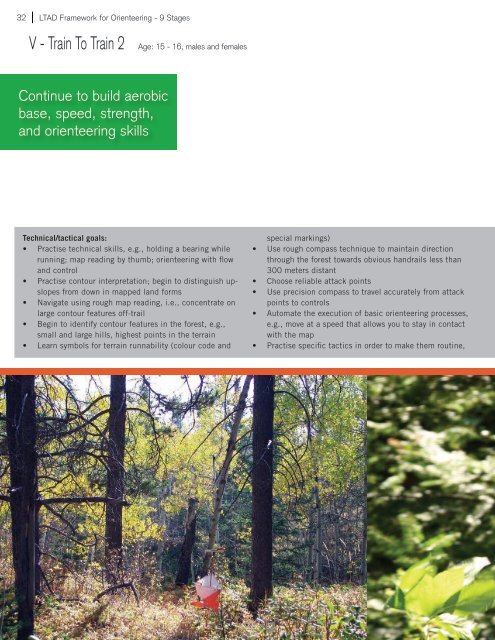train to win - Canadian Orienteering Federation
train to win - Canadian Orienteering Federation
train to win - Canadian Orienteering Federation
Create successful ePaper yourself
Turn your PDF publications into a flip-book with our unique Google optimized e-Paper software.
32 LTAD Framework for <strong>Orienteering</strong> - 9 Stages LTAD Framework for <strong>Orienteering</strong> - 9 Stages 33<br />
V - Train To Train 2 Age: 15 - 16, males and females<br />
Continue <strong>to</strong> build aerobic<br />
base, speed, strength,<br />
and orienteering skills<br />
Technical/tactical goals:<br />
• Practise technical skills, e.g., holding a bearing while<br />
running; map reading by thumb; orienteering with flow<br />
and control<br />
• Practise con<strong>to</strong>ur interpretation; begin <strong>to</strong> distinguish upslopes<br />
from down in mapped land forms<br />
• Navigate using rough map reading, i.e., concentrate on<br />
large con<strong>to</strong>ur features off-trail<br />
• Begin <strong>to</strong> identify con<strong>to</strong>ur features in the forest, e.g.,<br />
small and large hills, highest points in the terrain<br />
• Learn symbols for terrain runnability (colour code and<br />
special markings)<br />
• Use rough compass technique <strong>to</strong> maintain direction<br />
through the forest <strong>to</strong>wards obvious handrails less than<br />
300 meters distant<br />
• Choose reliable attack points<br />
• Use precision compass <strong>to</strong> travel accurately from attack<br />
points <strong>to</strong> controls<br />
• Au<strong>to</strong>mate the execution of basic orienteering processes,<br />
e.g., move at a speed that allows you <strong>to</strong> stay in contact<br />
with the map<br />
• Practise specific tactics in order <strong>to</strong> make them routine,<br />
e.g., start the race slowly and carefully <strong>to</strong> get used <strong>to</strong> the<br />
map and scale, and <strong>to</strong> conserve energy for later in the<br />
race; take safer than normal routes early and late in the<br />
course (when excited and/or tired)<br />
• Study a wide variety of orienteering maps and practise<br />
choosing routes between map features<br />
Physical goals:<br />
• Girls: likely a greater response <strong>to</strong> Strength/Anaerobic<br />
Lactic Capacity/Anaerobic Lactic Power <strong>train</strong>ing tasks<br />
(Strength/ALC/ALP, see diagram p. 13)<br />
• Girls and boys: Continue development of aerobic capacity<br />
and basic speed (


